|
 |
|
| Part 1 Preparation, Fukuoka Airport to Beppu Spa |
| Part 2 Yufuin, Takachiho Gorge, Aso Kusasenri |
| Part 3 Yanagawa, Oura Church, Glover Garden |
| Part 4 Dazaifu Shrine, This and That |
|
|
|
Part 4
Dazaifu-Tenmangu, This and That |
|
December 26th, the last day.
I got up at 6:00, 1 hour later than usual. I may be tired.
Breakfast of Japanese style at 7:00. |
|
| Dazaifu-Tenmangu Shrine
Leaving the hotel in Unzen Spa at 8:00, we got to Dazaifu-Tenmangu at 11:30,
after shopping at 2 souvenir shops on the way.
The lady guide F led us from the parking area to the "Chusei no Torii"
(Torii of Medieval Period), overlooking Dazaifu Station of Nishitetsu Railway.
From now we have a free sightseeing time of 1 hour and a half including
lunch time.
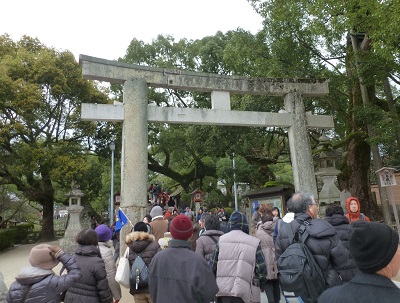
-------
I would like to get help from Wikipedia on the explanation of Dazaifu Tenmangu
as follows, though a little bit long.
Dazaifu Tenmangu is a Shinto shrine in Dazaifu, Fukuoka Prefecture. It
is built over the grave of Sugawara no Michizane and is one of the main
shrines dedicated to Tenjin, the deified form of Michizane.
Michizane was a gifted student who composed many poems dedicated to his
favorite plum trees. Said to be favored by the gods, Michizane raised the ire of the Fujiwara
clan, who exiled him to Kyushu. Michizane spent his exile studying, and died at the age of 57.
When Michizane died, his body was carried by an ox that stopped near a
Buddhist monastery. Unable to move the body along, Michizane was buried
there by his follower, Umasake no Yasuyuki, and the shrine was built there. Today, a statue of an ox stands nearby to commemorate the event. It's also said that the plum tree inside the shrine flew from Kyoto to
be reunited with Michizane in his death, and that it is always the first
plum tree to bloom in Japan.
Soon after Michizane died, five members of the Fujiwara clan, the royal
family involved in Michizane's exile, died by a lightning that struck the
clan's castle. Michizane, deified as Tenjin, was thus seen as a vengeful
spirit. When disasters struck Kyoto, the same royal family aimed to appease
Michizane's spirit and, as penance, reinstated his position and rank posthumously.
Through this appeasement, Tenjin's reputation became associated with literature
and education.
|
Wikipedia also explains about the shrine like this.
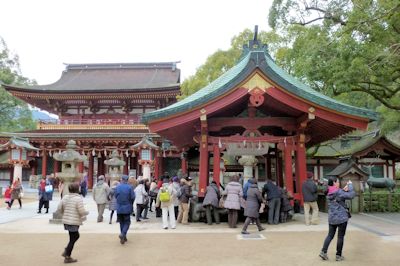
| The shrine's precinct spans over 3,000 acres (12 km2) and includes several structures. Its honden (main shrine) was first built
by Umasake no Yasuyuki in 905, two years after the death of Michizane.
A larger structure was constructed by the Fujiwara clan in 919 but was
destroyed in a fire during a civil war. The Momoyama-style shrine visitors
see today dates from 1591 and is an Important Cultural Property. |
The grounds also contain two ponds, a bridge and a treasure house. One pond is a traditional garden style, shinji ike, named for being shaped to resemble the kanji character for "heart."
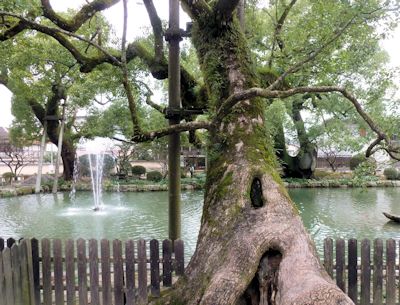
As well as the main shrine dedicated to Tenjin there are auxiliary and
branch shrines of many other kami (gods). The auxiliary shrine honden (main
hall) is an Important Cultural Property.
The shrine is also known for its 6,000 ume (Japanese apricot) trees belonging
to 167 varieties. One tree, known as Tobiume, stands directly to the right
of the honden.
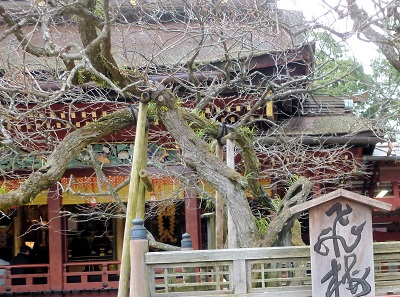
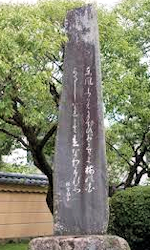 ------- -------
Just after the entrance gate "Chusei no Torii", there was the monument of Michizane's waka poem.
When the east wind blows let it send your fragrance, oh plum blossoms;
although your master is gone, do not forget the spring,
(東風ふかば におひおこせよ 梅の花
あるじなしとて 春なわすれそ)
We walked across Taiko-bashi (Drum Bridge) on the pond of Shinji-ike, purified
our hands at Chozu-ya, went under Ro-mon Gate seeing Shin-gyu (ox of god)
on the right side, and Main Shrine appeared just before our eyes.
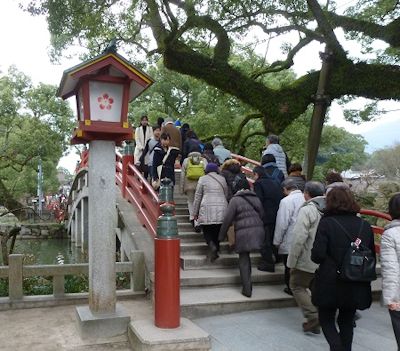 |
| Taiko-bashi |
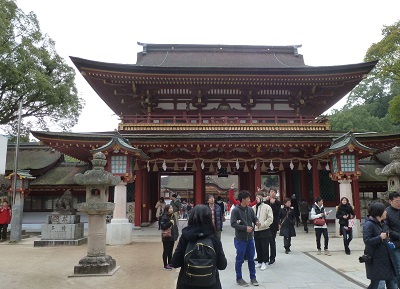 |
| Ro-mon |
 |
| Main Shrine |
 |
| Celebration Photo near Tobi-ume |
Our couple strolled around Main Shrine under a beautiful sky.
We ate a grilled yuzu bean cake stamped with the pattern of a plum tree
flower called "umegae-mochi" (120 yen).
Surely I bought a talisman for the safety of my family and relatives and
against evil.
Would you see the attached following pictures, since I cannot explain further?
|
|
| Dazaifu Tenmangu, Other Pictures |
|
We dropped in at Komyo-zenji Temple on the way back, under the advice of
a friend of this trip. He said it is celebrated for its Karesansui garden,
the only example in Kyushu.
Entering the path on the left, it was situated at the end.

It is the Zen temple of Rinzai sect, founded by Tetsugyu Enshin in 1273
(Kamakura Period).
It is also said popular as "Kokedera" (Moss Temple).
We felt at home, viewing a comfortable Japanese garden.
|
|
|
In the flight back
Our couple had a strange and precious experience in the plane JAL 318.
It took off at 15:00 from Fukuoka Airport back to Tokyo.
Our seat was for three people at the front row and like of the first class.
Lucky! But why?
The tour attendant never had thoughtfully arranged this seat for us. He
couldn't have favored us, and I did not remember any benefit I had done.
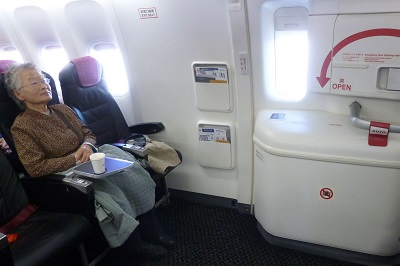
A flight attendant, finding we looked puzzled, spoke to us.
She said, "Could you read this paper ? If you accept its request,
we will be happy to keep this seat for you."
Actually, this seat was for the passengers who, in case of the plane's
emergency, had to be the last to escape and would help other passengers
be led safely under the crew's advice.
We read the paper through carefully and accepted its gist willingly.
Thanks to it, we not only enjoyed the most wonderful flight, but also no
trouble happened at all. Thanks a lot, the goddess of fortune.
|
|
| This and That
Mr T, Tour Attendant
Attendant T is working for the Kyushu Branch of Hankyu Trapics. He met
us at Fukuoka Airport.
He did not make us tour members be tired wholely during the 4-day trip.
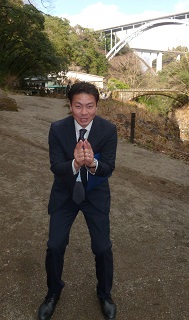 He was born and brought up in Kyushu. So, he had good knowledge and informations
about each place to visit. Lady guide F seemed to appreciate his cooperation
very much, which contributed to our satisfactory understanding. He was born and brought up in Kyushu. So, he had good knowledge and informations
about each place to visit. Lady guide F seemed to appreciate his cooperation
very much, which contributed to our satisfactory understanding.
He looked like Mr. Goromaru, a hero of rugby, to me. When I said so, he nodded, saying, "I feel honored. I heard the same thing from some other members, too".
The photo here (at Takachiho Gorge) is Mr. T, assuming a pose of the famous
rugby hero.
One Month behind the Schedule
I had cooperated with a Spanish lady for nearly a month since last year-end.
It was because I came to be concerned with the two works she put emphasis
on by chance.
One was the article "Camino de Santiago's Success" carried in
the English newspaper INDEPENDENT, which is in the Zakki-cho (Notebook)
as the 95th story of this homepage.
She has been striving for the friendship between Camino de Santiago in Spain and Kumano-kodo (Kumano Ancient Road) in Japan. Related to this work, she introduced this article on the Facebook. Reading it, I understood it had good relationship with Shikoku Pilgrimage and Kumano-kodo, and translated it into Japanese for the Japanese people and got her appreciation.
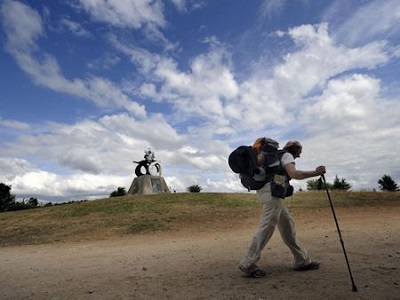
Another was her speech in Spanish at the meeting of Japanese gardens held
at Santiago de Compostella in autumn last year. After that, she put it
into a paper and translated it into English.
I received its English edition attached to her email at the beginning of
this year when I finished the translation of the above article. I got interested
again in the content and made up my mind to translate it into Japanese
not only for her but for myself.
This time, I found it was too much for me to handle. I think I understand
the beauty of Japanese gardens, but with no more knowledge nor emotion,
this paper was just philosophy that I am weakest in.
Nevertheless, I worked intensely and managed to complete it at last.
I may have the honor of her making use of my Japanese translation for some
purpose in the future.
Therefore I should not open it before she and her group accept it.
With this and that, this travelogue has been delayed until now.
Whether I was absorbed in another matter or not, I have to confess that
some of my memories are vague and so the workmanship is unsatisfactory.
And yet, since the motivation for this trip was among my intention to let
overseas people know the good points of Japan, I should not skip through
it.
I finish the Japanese version this much. I am going to translate it into
English from tomorrow. (As of February 6, 2016)
-----
I finally completed the English translation on February 14, just one month
later than I promised Mr. T and a couple of the tour members.
|
|
| Going back, Other Pictures |
|
| Reading: 17' 27" |
| Total Reading Time: 1:06:47 |
|
|
|
|
| Part 1 Preparation, Fukuoka Airport to Beppu Spa |
| Part 2 Yufuin, Takachiho Gorge, Aso Kusasenri |
| Part 3 Yanagawa, Oura Church, Glover Garden |
| Part 4 Dazaifu Shrine, This and That |
|
|
|
|
|
|
|
|
|
|